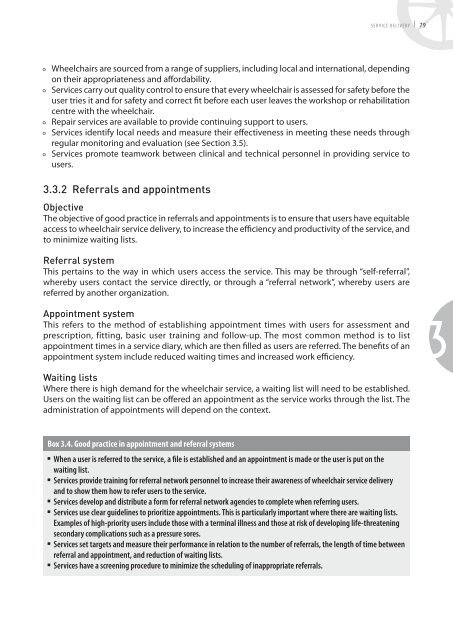Manual Wheelchairs - World Health Organization
Manual Wheelchairs - World Health Organization
Manual Wheelchairs - World Health Organization
You also want an ePaper? Increase the reach of your titles
YUMPU automatically turns print PDFs into web optimized ePapers that Google loves.
servIce delIvery I 79<br />
• <strong>Wheelchairs</strong> are sourced from a range of suppliers, including local and international, depending<br />
on their appropriateness and affordability.<br />
• Services carry out quality control to ensure that every wheelchair is assessed for safety before the<br />
user tries it and for safety and correct fit before each user leaves the workshop or rehabilitation<br />
centre with the wheelchair.<br />
• Repair services are available to provide continuing support to users.<br />
• Services identify local needs and measure their effectiveness in meeting these needs through<br />
regular monitoring and evaluation (see Section 3.5).<br />
• Services promote teamwork between clinical and technical personnel in providing service to<br />
users.<br />
3.3.2 Referrals and appointments<br />
Objective<br />
The objective of good practice in referrals and appointments is to ensure that users have equitable<br />
access to wheelchair service delivery, to increase the efficiency and productivity of the service, and<br />
to minimize waiting lists.<br />
Referral system<br />
This pertains to the way in which users access the service. This may be through “self-referral”,<br />
whereby users contact the service directly, or through a “referral network”, whereby users are<br />
referred by another organization.<br />
Appointment system<br />
This refers to the method of establishing appointment times with users for assessment and<br />
prescription, fitting, basic user training and follow-up. The most common method is to list<br />
appointment times in a service diary, which are then filled as users are referred. The benefits of an<br />
appointment system include reduced waiting times and increased work efficiency.<br />
Waiting lists<br />
Where there is high demand for the wheelchair service, a waiting list will need to be established.<br />
Users on the waiting list can be offered an appointment as the service works through the list. The<br />
administration of appointments will depend on the context.<br />
Box 3.4. Good practice in appointment and referral systems<br />
n When a user is referred to the service, a file is established and an appointment is made or the user is put on the<br />
waiting list.<br />
n Services provide training for referral network personnel to increase their awareness of wheelchair service delivery<br />
and to show them how to refer users to the service.<br />
n Services develop and distribute a form for referral network agencies to complete when referring users.<br />
n Services use clear guidelines to prioritize appointments. This is particularly important where there are waiting lists.<br />
examples of high-priority users include those with a terminal illness and those at risk of developing life-threatening<br />
secondary complications such as a pressure sores.<br />
n Services set targets and measure their performance in relation to the number of referrals, the length of time between<br />
referral and appointment, and reduction of waiting lists.<br />
n Services have a screening procedure to minimize the scheduling of inappropriate referrals.<br />
3

















